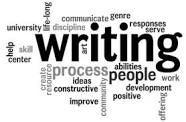We currently have all the capacity, expertise, programs, leaders, regulations, and wealth required to end unnecessary suffering and create an alternative future.
- Peter Block |
Basic Writing Tips
 There are many types of writing and we simply don’t have the time or space to go in depth on them. Remembering all the rules is hard. What I’ve learned is that if I follow the basic format for writing an essay. It would help me to maintain the focal point of the paper. In short it made my writing easier to convey. With that in mind we’ve created a basic writing overview. To offer basic writing tips that will hopefully set you off on an effective writing path, or simply help you hone your skills.
There are many types of writing and we simply don’t have the time or space to go in depth on them. Remembering all the rules is hard. What I’ve learned is that if I follow the basic format for writing an essay. It would help me to maintain the focal point of the paper. In short it made my writing easier to convey. With that in mind we’ve created a basic writing overview. To offer basic writing tips that will hopefully set you off on an effective writing path, or simply help you hone your skills.
The Outline
Why an Outline is important
An outline can help you organize the information that you want to covey whether writing a personal or legal letter, creative writing, and academic writing. It gives you an ordered overview of your writing, which can help you see something you may have missed or need to remove later. It truly aids in the overall writing process.
How to Create an Outline
An outline allows a writer to categorize the main points, to organize the paragraphs into an order that makes sense, and to make sure that each paragraph/idea can be fully developed. Essentially, an outline helps prevent a writer from getting stuck when performing the actual writing.
An outline provides a map of where to go with the writing. A well-developed outline will show what the thesis of the essay is, what the main idea of each body paragraph is, and the evidence/support that will be offered in each paragraph to substantiate the main points.Organize the ideas, arrange the ideas in sections and subsections from general to specific. Create main headings and sub headings.
Here’s an easy way to remember how to structure your writings:
-
- Introduction: Tell them what you’re going to tell them.
- Body:Explain what you said you would tell them
- Conclusion: Tell them what you told themDetermine the purpose of your writing.Brainstorm, make a list of important points in your writing.
Paragraph development
A paragraph is a collection of sentences that all relate to one main idea or topic.An effective paragraph describes, explains and supports the topic sentence. If the topic sentence is adequately supported, or if the reader is left with questions after reading the paragraph, the paragraph has not been adequately developed. A good rule of thumb to follow is to make sure that a paragraph contains at least four sentences which explain and elaborate on the topic sentence.
- Remember: you are trying to say something (your premise) which should be clear and understandable.
- Topic sentence: introduce what are you talking about. The first sentence in each paragraph should give the outline or the basic idea for the paragraph. Read the first sentence of each paragraph and see if it pretty much provides a decent outline to the paper, the request, the letter or whatever you’re writing.
- Body: explain what you’re talking about; your argument, description, examples and/or personal experiences.
- Conclusion: wrap it up, drive your point home.
Grammar
Grammar can be the difference between getting your point across or being totally misunderstood. The words you use and how you use them are very important components of writing. Here are some grammar tips to help strengthen your writing skills that we found at GrammarBook.com. for more information visit- http://www.grammarbook.com/grammar/effWrite.asp
- Use concrete rather than vague language.
- Avoid vague language.
- Use active voicewhenever possible. Active voice means the subject is performing the verb. Passive voice means the subject receives the action.
- Avoid overusing there is, there are, it is, it was,
- Do not use slang, limiting language limits your ability to convey your point to vast audiences.
Second guess yourself!
Write drafts! Computers are great for coming back to something and making big changes like moving paragraphs to reorder your argument. The point of drafting is to translate your ideas into written organization without being constrained by word choice, sentence structure, etc.
- Proofread to check for spelling, grammar and flow.
- Know yourself. Are there mistakes you make more often than others? Double check for those!
- Know your goal: what is your point? Are you conveying it clearly?
- Writing drafts will relieve the pressure knowing that you can go back later and edit.
Remember to re-read and look especially closely for miss-spelled words or wrong words like these:
|
|
Writer’s block
Writer’s block is a condition, primarily associated with writing, in which an author loses the ability to produce new work or experiences a creative slowdown. The condition ranges in difficulty from coming up with original ideas to being unable to produce a work for years. Throughout history, writer’s block has been a documented problem.
- Write through it, don’t think just write!
- Walk away for a while and return with a fresh perspective
- Write it as a draft this will relieve the pressure knowing that you can go back later and edit
“7 Strategies to Outsmart Writer’s Block” offers great strategies for ,overcoming writer’s block. For more information click here:https://litreactor.com/columns/7-strategies-to-outsmart-writers-block
Specifics
Apostrophes:are used to indicate this possession in the following ways: If the noun does not end in -s (in most cases this means it is singular), add -‘s.
For more information on apostrophes click here: https://swandawritingresources.wikispaces.com/file/view/
Commas- Use commas to separate independent clauses when they are joined by any of these seven coordinating conjunctions: and, but, for, or, nor, so, yet. 2. Use commas after introductory clauses, phrases, or words that come before the main clause.
For more information on commas click here:
http://www.grammarbook.com/punctuation/commas.asp
Semi-colons, colons and dashes-
An independent clause is a group of words that can stand on its own (independently)—it is a complete sentence. Semi-colons can be used between two independent clauses. The semi-colon keeps the clauses somewhat separate, like a period would do, so we can easily tell which ideas belong to which clause.s a mark of punctuation used to set off a word or phrase after an independent clause or to set off a parenthetical remark (i.e., words, phrases, or clauses that interrupt a sentence). The dash is longer than the hyphen.
For more information on semi-colons, colons and dashes click here:
http://writingcenter.unc.edu/handouts/semi-colons-colons-and-dashes/


